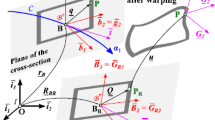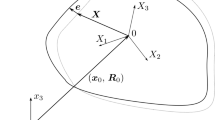Abstract
Impact problems involving flexible bodies that undergo largerotations and translations were solved by using the floating frame ofreference approach. Analytically defined modes were selected to describedeformation. Different mode shapes can be used depending on the type ofattachment between the body frames of reference and the flexible bodies.Evaluating the kinematic coefficient of restitution during impactentails using the equivalent rigid body velocities of the flexiblebodies. In general, however, such velocities cannot be identified withreference velocities.
When the colliding bodies can undergo large translations, freeattachments allow the use of mode shapes that possess zero totalmomentum. In this case, reference motion coincides with the equivalentrigid body motion of the flexible bodies and is not coupled to elasticmotion. When the colliding solids can rotate freely, the use of modeshapes with a zero angular momentum does not uncouple reference andelastic motion. However, if small deformation occurs during freerotation of the flexible body, the derivative of the reference angleremains roughly constant. Such a derivative can be interpreted as theequivalent angular velocity of the flexible body. When using a rigidattachment between the body frames of reference and the flexible bodies,reference motion does not coincide with the equivalent rigid bodyvelocity of the flexible bodies, which leads to non-constant referencevelocities when the bodies move freely. As a result, the equivalentrigid body velocities must be evaluated as linear combinations ofreference and elastic velocities.
As shown in this paper, the use of free or rigid attachments asreference conditions, and their corresponding mode shapes allows theaccurate description of impact-induced elastic waves. However, theevaluation of elastic efforts with rigid attachments provides spuriouselastic forces at the attachment point. Such forces decrease as thenumber of modes increases.
Similar content being viewed by others
References
Shabana, A.A, Dynamics of Multibody Systems, John Wiley & Sons, New York, 1989.
De Veubeke, B.F., 'The dynamics of flexible bodies', International Journal of Engineering Science 14, 1976, 895-913.
Shabana, A.A., 'Resonance conditions and deformable body co-ordinate systems', Journal of Sound and Vibration 192(1), 1996, 389-398.
Cavin, R.K. and Dusto, A.R., 'Hamilton's principle: finite element methods and flexible body dynamics', AIAA Journal 15(12), 1977, 1684-1690.
Agrawal, O.P., 'Application of deformable body mean axis to flexible mechanical systems', Ph.D. Thesis, Mechanical Engineering, University of Illinois, Chicago, IL, 1984.
Escalona, J.L., Mayo, J.M., Hu, B., and Eberhard, P., 'Dynamics of axial impacts on rods', in Proceedings of the Tenth World Congress on the Theory of Machines and Mechanisms, Oulu, Finland, 1999, 116-121.
Hughes, T.J.R., Taylor, R.L., Sackman, J.L, Curnier, A, and Kanoknukulchai, W., 'A finite element method for a class of contact-impact problems', Computer Methods in Applied Mechanics and Engineering 8, 1976, 249-276.
Palas, H., Hsu W.C., and Shabana, A.A., 'On the use of momentum balance and the assumed modes method in transverse impact problems', Journal of Acoustics and Vibration 114, 1992, 364-373.
Escalona, J.L., Mayo, J.M., and Domínguez, J., 'A critical study of the use of the generalized impulse-momentum balance equations in flexible multibody systems', Journal of Sound and Vibration 213(3), 1998, 523-545.
Yigit, A.S., 'On the use of an elastic-plastic impact law for the impact of a single flexible link', Journal of Dynamic Systems, Measurement and Control 117, 1995, 527-533.
Author information
Authors and Affiliations
Rights and permissions
About this article
Cite this article
Escalona, J.L., Mayo, J.M. & Domínguez, J. Influence of Reference Conditions on the Analysis of Impact-Induced Elastic Waves. Multibody System Dynamics 7, 209–228 (2002). https://doi.org/10.1023/A:1014410012482
Issue Date:
DOI: https://doi.org/10.1023/A:1014410012482




